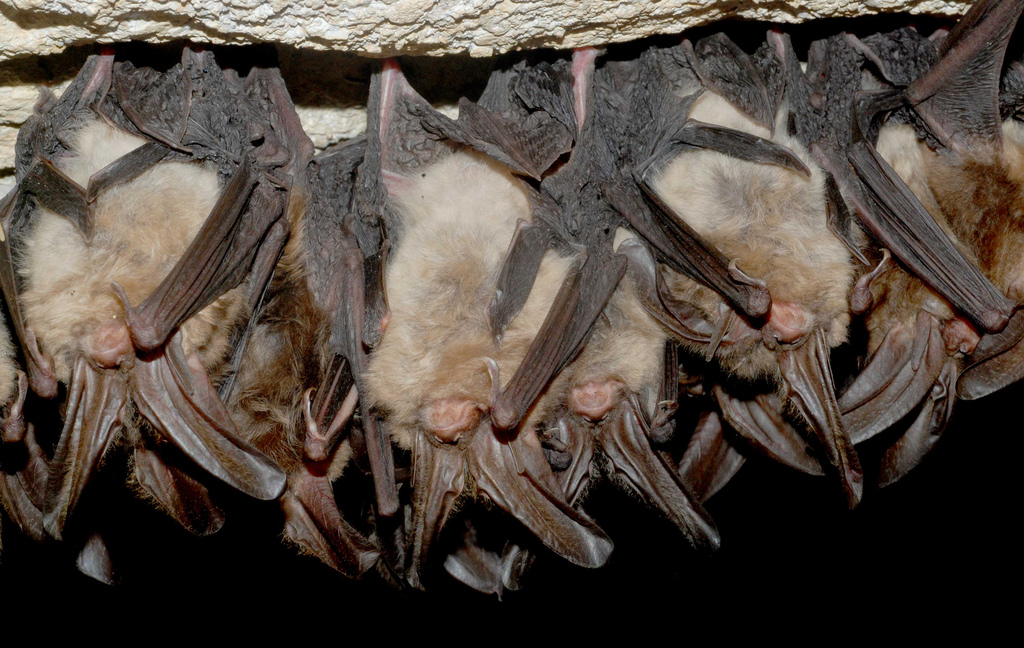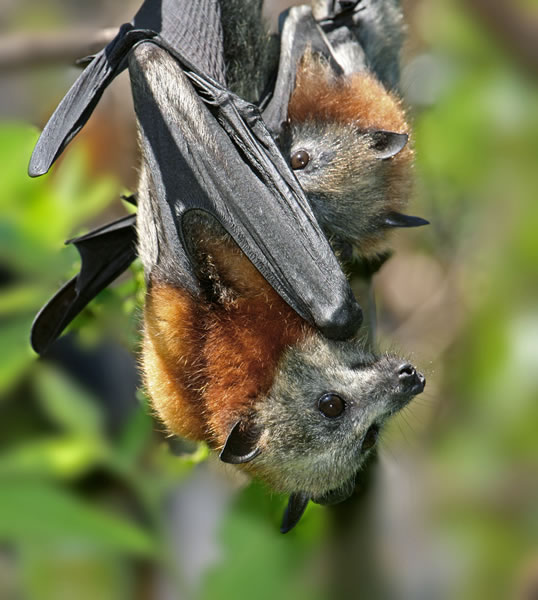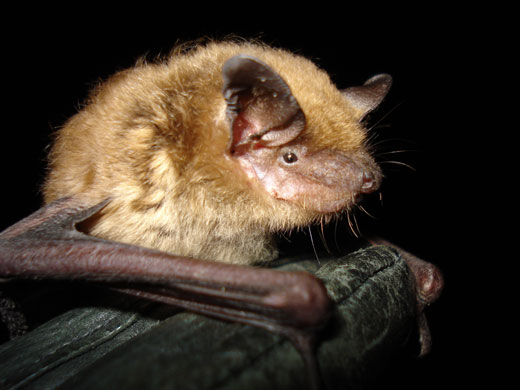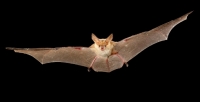Bats ARE cool, and because bats have been found to do some really important things for the environment, many other people now think they're cool too. We now know that bats are crucial pest controllers, seed dispersers and crop pollinators and have helped aid scientists in the understanding of aeronautics, anti-coagulants and echolocation. These fascinating flying mammals continue to be misunderstood, yet thanklessly serve a critical niche in our ecosystem.
 Wisconsin has 7 species of bats (8 if you count one documented sighting of an Indiana Bat in the 1950's) which are found throughout the state in caves, trees, crevices and housing structures. Four of our species are cave or hibernating bats and three of them are tree bats or migratory bats. The four cave bats - Big Brown, Little Brown (left), Eastern Pipistrelle and Northern Long-eared - are all threatened species in Wisconsin. This classification means that in the foreseeable future, this species will become endangered. The arrival of White-nose Syndrome in Wisconsin has caused a severe threat to Wisconsin's cave bats and scientists are rushing to try to learn more about the death-causing fungus before it is too late.
Wisconsin has 7 species of bats (8 if you count one documented sighting of an Indiana Bat in the 1950's) which are found throughout the state in caves, trees, crevices and housing structures. Four of our species are cave or hibernating bats and three of them are tree bats or migratory bats. The four cave bats - Big Brown, Little Brown (left), Eastern Pipistrelle and Northern Long-eared - are all threatened species in Wisconsin. This classification means that in the foreseeable future, this species will become endangered. The arrival of White-nose Syndrome in Wisconsin has caused a severe threat to Wisconsin's cave bats and scientists are rushing to try to learn more about the death-causing fungus before it is too late.
 White-nose Syndrome (Pseudogymnoascus destructans) is particularly scary because it disrupts a bat's hibernation, waking them often and leading the bat to dehydration, starvation or death due to exposure. Wisconsin's cave bats bear brutal Wisconsin winters by dwelling in caves, mines or buildings (often in large numbers) when food becomes scarce and the weather turns cold. They drop their thermoregulatory set-point to slow down their metabolism, body temperature and appetite. And while bats normally wake occasionally from their slumber to urinate, stretch and sometimes copulate, they're not designed to wake frequently. White-nose Syndrome has a death-rate of over 90% and spreads rapidly by contact in colder environments. Given the close, cool quarters of many bat hibernaculums, our cave bats are in grave danger. Take into account their low birth rate and slow population growth and the cave bats are facing an ominously uncertain future.
White-nose Syndrome (Pseudogymnoascus destructans) is particularly scary because it disrupts a bat's hibernation, waking them often and leading the bat to dehydration, starvation or death due to exposure. Wisconsin's cave bats bear brutal Wisconsin winters by dwelling in caves, mines or buildings (often in large numbers) when food becomes scarce and the weather turns cold. They drop their thermoregulatory set-point to slow down their metabolism, body temperature and appetite. And while bats normally wake occasionally from their slumber to urinate, stretch and sometimes copulate, they're not designed to wake frequently. White-nose Syndrome has a death-rate of over 90% and spreads rapidly by contact in colder environments. Given the close, cool quarters of many bat hibernaculums, our cave bats are in grave danger. Take into account their low birth rate and slow population growth and the cave bats are facing an ominously uncertain future.
 Wisconsin's cave bats breed in the fall and delay fertilization until the spring. Six weeks later a single pup is born to the mother. Wings are too small and underdeveloped at birth to take flight, so the pup clings to its mother suckling milk (left) until it is ready to leave. At 6-8 weeks it will become independent and leave its mother.
Wisconsin's cave bats breed in the fall and delay fertilization until the spring. Six weeks later a single pup is born to the mother. Wings are too small and underdeveloped at birth to take flight, so the pup clings to its mother suckling milk (left) until it is ready to leave. At 6-8 weeks it will become independent and leave its mother.
The Fantastic Four!
The following four bats are Wisconsin's bats most at risk of White-nose Syndrome and will likely become endangered in the near future.
Little Brown (Myotis lucifugus): One of Wisconsin's most common bats. This rich brown to olive-colored bat feeds primarily on soft-bodied aquatic invertebrates. It dwells in tree cavities and snags in the warm months and can often be found hibernating with Big Brown bats in the winter.
 Big Brown (Eptesicus fuscus) (right): Larger than a Little Brown with dark brown fur and a lighter brown underside, this bat feeds primarily on beetles in the tree story. In the summer they roost in large numbers in buildings and bat houses. Come winter, they hibernate in appropriate caves or mines.
Big Brown (Eptesicus fuscus) (right): Larger than a Little Brown with dark brown fur and a lighter brown underside, this bat feeds primarily on beetles in the tree story. In the summer they roost in large numbers in buildings and bat houses. Come winter, they hibernate in appropriate caves or mines.
Northern Long-eared (Myotis septentrionalis): Similar in appearance to a Little Brown, but much less common and with a duller, lighter brown coat. This myotis forages over small streams and ponds and along hillsides and ravines. It is thought to roost in the summer under tree bark and in buildings. In the winter they move into caves and often cohabitate with other bat species.
Eastern Pipistrelle (Perimyotis subflavus): Wisconsin's smallest bat. The little pip actually has tri-colored hair giving it a yellowish appearance. It forages along forest edges and waterways. While little is known about the summer habitat for this species, scientists do know that is hibernates in caves singlely or in small groups.
Fun Facts:
- Die Fledermaus! Although in many languages the word bat is actually a cognate for the word "mouse", the bat is not even closely related to a mouse and shares a lineage more closely related to carnivores (weasels, wolves, etc.) and even-toed ungulates (camels, hippos, etc.).
- Mutt and Jeff. The world's largest bat is the Malayan Flying Fox with a wing span of up to 6 feet! Compare that to the world's smallest bat, the Kitties Hog-nosed bat, who has a diminuative wing-span of 6 inches.
- Faster than a speeding bullet! The world's fastest bats have been clocked at flying over 50 mph! Maybe we should ride bats to work instead of cars.
- A walk on the moon? The pelvic girdle of a bat is structured so that it can not stand. Instead, the bat does everything upside-down and has no problem with blood circulationtion because they are too light to be affected by gravity.
- One bad apple... While any mammal can carry rabies, bats get a bit of a bad rap. It is thought that only about .5 to 1% of bats have rabies. So why the unfair repuatation? Sick bats are noticed more often as they become disoriented and weak (therefore closer to humans and out of trees and caves). However, wild bats should never be handled as rabies is a fatal disease.
- Blind as a bat?! Despite common myth, no bat is blind. While most bats have small poorly developed eyes, even the "blindest" bat sees about as well as a rat.
- Old as the hills. Wisconsin cave bats live an average of 20 years, but the oldest recorded age of any bat is over 40 years old!
Want to learn more?
Explore the wide world of bats! Come see for yourself just how large a flying fox's wingspan really is and learn what it is like to be a bat biologist at the 2014 Wisconsin Bat Festival!
This article was written uses the following references: www.dnr.wi.gov, www.batconservation.org, www.wikipedia.org and www.wiatri.net.
Click here to read more about White-nose syndrome in Wisconsin.





